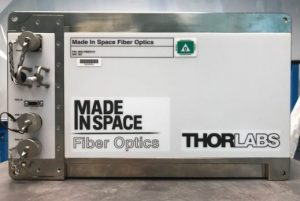
A new ZBLAN-manufacturing machine that will increase the production of off-earth optical fiber will be on its way to the space station soon.
(Photo Credit: © Made In Space)
The common fibers used through our telecommunications infrastructure and are located within most fiber network maps are made from silica glass (SiO2). Optical fiber cables have surpassed what was capable with electrical cables and made the digital modern world a possibility today. These threads are smaller than a human hair and pulsate light transmissions.
A fluoride glass optical fiber (ZrF4-BaF2-LaF3-AlF3-NaF) or ZBLAN has 10 to 100 times more signal power and is lighter than the commonly used silica glass option. This would be the logical upgrade for anyone using or trying to locate fiber. However, defects occur when this specific optical fiber ZBLAN is developed on Earth due to gravity-related phenomena that creates imperfections such as crystals within the chemicals. In an environment with lighter gravity, the cables can be properly developed and then return to Earth and work almost flawlessly.
Taking Optical Fiber to Space
Towards the end of 2017 Made in Space partnered with Thorlabs. Together the companies developed and launched a machine that develops fiber and sent it to the International Space Station (ISS). Not only did this have the potential to open Space for commercial use but it also solved the gravity-related issues by developing the fiber in a microgravity environment. After a year or so of successful production, more and more companies were lining up to order this superior optical fiber.
Stepping Up Production
The positive results seen by ZBLAN production has created a high demand. Made in Space is going to launch an even larger machine to the ISS for production within the next year. The company will be running further tests and could be open for purchase to the entire market by 2021. The valuable and lightweight product is worth around $100 a meter which is significantly more than the average $2 per meter of silica optical fiber cable. Future production tests could prove the viability of commercial space use.
The benefits of space manufacturing could be minimizing pollution, optimizing physical space, and minimization of the need for mechanical cooling. The benefits of producing ZBLAN optical fiber in space would enable the world to be connected like never before due to the low optical loss.
GeoTel Communications is proud to provide fiber location data. If your company could benefit from business intelligence like this, then contact us today.
Author: Valerie Stephen


